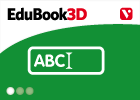Cargando...
Recursos educativos
-
Nivel educativo
-
Competencias
-
Tipología
-
Idioma
-
Tipo de medio
-
Tipo de actividad
-
Destinatarios
-
Tipo de audiencia
-
Creador
Lo más buscado
- Tintín
- Letras B
- Alteración del lenguaje
- Repaso de GA GO y GU
- Proyectos de ciencia
- Arte bizantino para segundo
- Sea animals
- Juegos matemáticos
- Animales dibujados para P4
- Antártico
- Día mundial del agua
- Cuentos ilustrados
- Repaso de lengua castellana para cuarto grado
- Actividades de repaso
- Aprender a montar en bici
-

Wedding Traditions
Anabel Sánchez Docente
- 1 lo usan
- 1587 visitas
A mash up of all the weddings that we have shot over the last two years. Whether it's Hindu, Sikh, American, or Muslim at the end of day its all about a drea...
-

Match. Characteristics of fungi
EduBook Organización
- 1840 visitas
Match the beginning of each sentence with the correct ending. The hyphae in moulds... Hyphae are collectively... Mushrooms, moulds and yeasts... Fungi obtain their food... The hyphae that have a…
-

Final self-evaluation 9.10 - The Plant Kingdom
EduBook Organización
- 1828 visitas
Are the following sentences true or false? Mosses do not have roots, stems or leaves. Seeds are part of fruit. Cotyledons contain nutritional reserves. Gymnosperm plants make spores to reproduce.
-

Complete. Spermatophytes
EduBook Organización
- 1820 visitas
Complete the text with the correct words: stem cultivate flowers leaves Spermatophytes are plants which reproduce using . They have three parts: the roots, the and the . Most of the plants we are…
-

Final evaluation 3 - The Animal Kingdom (II). Vertebrates
EduBook Organización
- 1807 visitas
Read the following description: “Carnivorous animal that lives in water when it is a larva and on land when it becomes an adult“. What type of animal does the phrase refer to? What other…
-

Answer. Time measurement
EduBook Organización
- 1819 visitas
Remember what you have studied in this section and answer: How many years are there in a century? How many years are there in a millennium? How many centuries are there in a millennium?
-

Check. The responses of plants
EduBook Organización
- 1789 visitas
Remember what you have studied in this section and answer the questions: Define tropisms and nastic movements. State the difference between them. Explain photoperiod to a classmate. How does it affect…
-

-

Comprehension check
EduBook Organización
- 1810 visitas
How many of Shakespeare’s plays have Italian settings? Why is this? How many versions of the Romeo and Juliet story were there before Shakespeare wrote his play? How did Shakespeare change Arthur…
-

Match. Amphibians
EduBook Organización
- 1674 visitas
Match each characteristic with the group of animals among which it is most common. They begin life as tadpoles. External fertilisation. Thin, moist, slippery skin. They have a tail.
Te estamos redirigiendo a la ficha del libro...












